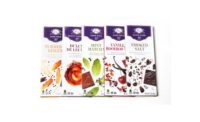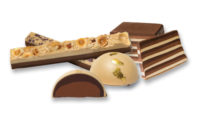“I’ve been travelling for four weeks, and this is the first time I’ve gotten back home for any real length of time,” Katrina Markoff, founder and ceo of Vosges Haut-Chocolat, tells me. And where has she been, I ask?
“I just came back from Kauai in Hawaii, visiting an herbal farm, which grows medicinal herbs such as turmeric, ginger, tulsi,” she replies excitedly, albeit in a still jet-lagged cadence. The Kauai Farmacy, founded in 2010, focuses on growing medicinal plants, using only composted manure and planting multiple species in a “symbiotic” manner, Markoff explains.
The Hawaii trip is merely one destination of many ports of call lately, which have included Cuba, Mexico and Bulgaria. For example, last year she traveled to Bulgaria’s Valley of the Roses, spending time there harvesting the famed roses for their rose oil.
“It’s critical to harvest the roses early in the morning, from 4 to 10 a.m. That’s when they are fully bloomed and the oil has come up to the petals,” she explains in a video posted on her website. As Markoff points out on the short clip, what differentiates the Bulgarian rose oil from others is its intensity, which delivers a truly special flavor note.
“Just being able to see the distillery and being able to harvest the roses was amazing,” she continues. “If you’re going to make chocolates with roses, you have to get the oil from Bulgaria.”
With Katrina being Katrina, of course, one just doesn’t stop at merely infusing chocolate with rose oil. It has to go a step further, which means allowing her creativity to pursue whatever that coupling evokes, be it pistachios, chestnuts or matcha green tea.
In essence, it reflects Vosges-Haut Chocolat's raison d’etre, to “harness the power of storytelling to open minds, spirits and palates through esteemed chocolate, inspiring us all to interact with the world in a new and creative way.”
For Markoff, there needs to be a story for her to do what she does, namely create and innovate using the medium of chocolate and all the wonderful ingredients that can go into a bar or bonbon.
At A Glance: Vosges-Haut Chocolat
Headquarters: Chicago
Sales: $30 million
Employees: 100
Output: 3.02 million lbs.
Products: Chocolate bars, truffles, caramel, toffee
Brands: Vosges, Wild Ophelia
Management team: Katrina Markoff, founder and ceo; Michael Brennan, president and coo.
As she explained in an earlier Candy Industry interview, “Chocolate is one of the most powerful words in the food dictionary, and the ability to tell stories through it is so ripe and able. People are really open to eating chocolate, and when you’re getting them to open their minds to new ideas through it, it can be a really powerful change agent.”
Sourcing plays a critical role in developing products that can tell the story. For example, the chocolate that Vosges -Haut Chocolat uses in its bars is specifically formulated to Markoff’s specifications. The types of chocolate used for truffles are also chosen based on the variety. All other ingredients go through the company’s Superior Sourcing Initiative process.
The process enables Markoff and her sourcing team to narrow down fields of potential suppliers through a multi-step evaluation.
To start, they seek organic, non-GMO and sustainably-grown ingredients. Once they have a few offerings of the same ingredient under consideration, Markoff and a tasting panel assess them side by side, measuring color, texture, flavor and quality.
After selecting one or two possible options, the ingredients are tested in recipes to see which one will best serve Vosges’ products. Not only does the multi-step process enhance the products’ caliber, but Vosges-Haut Chocolat's customers know the ingredients’ origins — information consumers continue to demand.
“People want to know where their food is coming from, and they want to understand the craft process that goes behind it,” Markoff says.
This year, the company’s been busy launching new items, all of which have their own story. In January, a new line of Vosges-Haut Chocolat bars came into the market. The five bars, Mint Matcha, Dulce de Leche, Vanilla Rooibos Tea, Smoked Salt and Turmeric Ginger, are reflective of trends permeating the premium chocolate sector: authenticity, transparency, health and wellness, she says.
Take for example, the Turmeric Ginger bar, which takes “the musky aroma of curry kissed with black peppercorn and intertwines with warm ginger and crisp coconut in a 45 percent cacao dark milk chocolate.”
The new line, which Markoff says took her longer to develop than most other items, taps into a group of consumers who are looking for a healthier chocolate. She cites the latest craze for turmeric, a natural healing spice known for supporting a balanced mood, wound healing, easing ache and discomfort, and loosening stiff joints, as emblematic of a “healthier” chocolate.
The Turmeric Ginger Bar has been “flying off the shelves,” Markoff says. “I see moringa and mushrooms as the next super foods. There’s a large segment of the population interested in alternative healing, particularly from sources such as China and India.”
That ties in with a penchant for products that have less sugar in them or use alternative sweeteners, such as honey, maple sugar or coconut sugar,” she adds.
At the same time, consumers are eager to have some fun with food.
“I’m seeing several examples of where candy meets chocolate,” Markoff says. ‘It’s a little weird, but there’s definitely a draw for the use of candy in chocolate.”
On her end, it’s a matter of being “creatively disruptive,” as with the launch this month of Wild Ophelia Cold Brew Chocolate Coffee Bites. Cold brew, which is the process of brewing coffee or tea using room temperature or cold water over an extended period of time to attain intense flavors, is, as Markoff describes, “so hot” now.
“Everybody seems to want it,” she adds.
The Cold Brew Chocolate Coffee Bites, which come four to a 1.7-oz pack, will be available in Mexican, Jet Black and Sea Salt Caramel Latte flavors.
The burst of new product launches dovetails with Markoff’s intent to take Vosge-Haut Chocolat to the “next level.”
“We’re making progress,” she says. The opening of the company’s 40,000-sq.-ft., LEED Silver-certified facility several years ago underscores that journey. The recent hiring of Mike Brennan as president and coo, formerly the coo of Peapod, designates another major milestone.
It’s also about getting her product in the hands of consumers looking for chocolates that excite and engage. Thanks to expanded distribution of its products across the United States, including natural foods specialty shops, the company will do exactly that. It should bode well for the company’s revenue projections, which are forecast to approach high, double-digit sales gains this year. One of those drivers will be the company's Wild Ophelia brand.
As Markoff explained to Candy Industry during Wild Ophelia’s launch in 2012, she saw an opportunity for connecting consumers with the growing sustainable agriculture movement, a way of bridging local farmers with chocolate.
“I wanted to use America as the focus of the brand, exposing consumers to this agricultural movement by introducing them to different seeds, different varietals, different craft processes and different farmers,” Markoff said.
And its worked. The Wild Ophelia line, which features all-natural and organic ingredients sourced from small farms and artisans, comes in Markoffian and uniquely American flavors: Barbeque Potato Chip, Peanut Butter Banana, Beef Jerky, Almond Sea Salt and Caramelized Crispy. Since the launch, Wild Ophelia has come out with a line of peanut butter cups in Maine Sea Salt, Caramelized Banana, Smoked Salt, and Toasted Coconut varieties.
“Our Wild Ophelia line is very accessible, and we expect it to become a bigger brand that Vosges,” she says. It also conveys a personal connotation for Markoff.
“You don’t really see any brands in chocolate with a female face,” she explains. “I was looking for a strong role model for women. Wild Ophelia is a younger, wilder sister of Vosges, of me, who’s louder and more activist about sustainable agriculture.”
To encourage that kind of spirit in the business world, Markoff created the Wild Ophelia Accelerator Program, which encourages, educates, and propels American high school and college girls who have entrepreneurial dreams in food.
To fulfill this mission, Wild Ophelia provides three ambitious girls with the funds and mentorship needed to start a business. A portion of the sales from every chocolate sold is contributed to the Wild Ophelia Accelerator Program, awarding three grants per year. As the program grows, the number of grants awarded annually will increase
For eight to 12 weeks each year, three young women travel to Vosges’ Chocolate Temple, its headquarters and manufacturing complex in Chicago, where they learn about all aspects of food business: procurement, product development, manufacturing, graphic design, supply chains and innovation. They’re also given $5,000 to further the development of their own businesses.
“I’m a strong supporter of the girl-boss cause,” she says. “It’s all about inspiring girls to start companies at a younger age. Part of this stems from me being encouraged to be an entrepreneur in high school.”
Markoff believes that by kick-starting girls’ entrepreneurial career early in their lives, they can be more impactful. The chocolate alchemist and entrepreneur hopes to make a similar foray in cocoa as well.
In addition to growing her own cocoa beans to provide a source for the company’s own bean-to-bar process at the plant, which is in its early stages, she is working with a cooperative in Haiti that has 500 female farmers as members.
“The aim is to help them grow the best quality beans in Haiti,” Markoff explains. She’s also exploring such opportunities in Ecuador and Bolivia. But why women farmers?
“Women in developing countries tend to invest more of their income back into their families and communities than men,” she responds.
As one would expect, Markoff isn’t only investing into causes, but into her business as well. Her grand plans of turning the 40,000-sq.-ft. office and manufacturing complex into a Chocolate Temple are also “progressing.”
As mentioned earlier, she has already begun grinding her own beans in the plant, although on a very small scale. This spring, the first phase of the Chocolate Temple project will begin with the planting of an outside garden — the western part of the building faces the Chicago River — and the build-out of the “Innovation Hall.”
Phase Two will commence the following year, with the completion of the innovation hall and a cafe concept and retail space. The offices have been completed and the production and packaging areas have been operational for the past three years.
The production and packaging area features two enrobing lines, a depositing line, a bar line, a flow wrapper, several foil wrapping units and a carton erector. Specialty items, such as Vosges’ Love Goddess Petit Cakes, are typically run on the two small enrobing lines while truffles are produced on the truffle line. The moulding line handles all bar production, including private-label items. A separate kitchen area allows for handwork, such as champagne truffles.
Excluding peak seasonal periods, the facility operates two shifts, Monday through Friday, with 30 to 40 production employees per shift.
Given the range of products Vosges offers, from handcrafted truffles and caramel toffee bonbons to premium chocolate bars and now Cold Brew Chocolate Coffee Bites, maintaining quality and efficiency remains challenging.
“We are evolving, always striving to being better,” Markoff says. Currently, she’s analyzing what can be done in the packaging area to optimize workflow. But don’t expect the special touches of elegance, like the perfectly hand-tied ribbons on truffle boxes to disappear.
Nor will the color of those boxes change. After all, not only is purple a shade that denotes royalty, but it symbolizes the seventh and final “crown” chakra, which is the path to enlightment in yoga.
“Purple represents soulfulness and regality; it’s about chocolate meditation and what we do. There’s a purpose in our work,” she says.
And it’s enlightening consumers and the chocolate community.

























